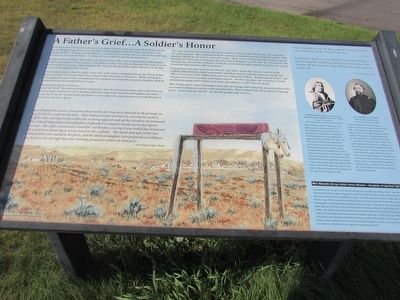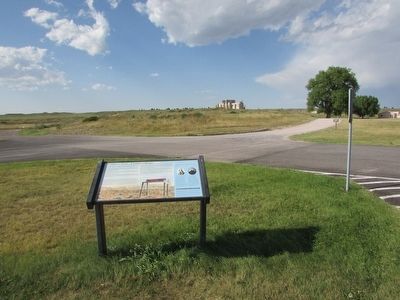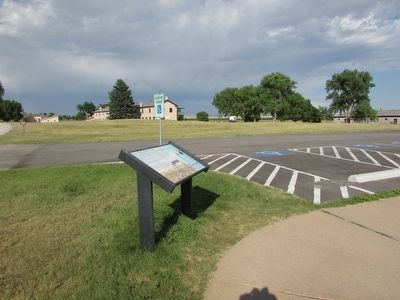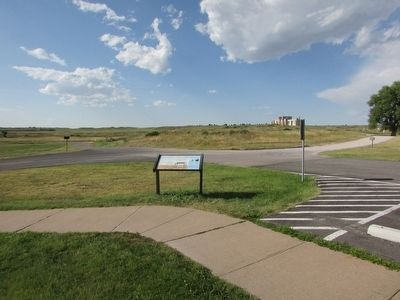Fort Laramie in Goshen County, Wyoming — The American West (Mountains)
A Fatherís Grief . . . A Soldierís Honor
Fort Laramie National Historic Site
Some days since I received a messenger from [Sinte Gleska], head chief of the Brule Sioux, saying that his daughter had died on the way here and had begged her Father to have her grave made with the whites . . . Wishing to do him honor . . . I rode out with several officers, and met him half way between the fort and he Platte . . I conducted him to the Fort and my headquarters.
So begins Colonel Henry Maynadierís account of one of the most extraordinary and poignant events in the annals of Fort Laramie. On March 8, 1866, Sinte Gleska (Spotted Tail) arrived at the fort bearing the remains of his daughter, Mni Akuwin (Brings Water Home Woman), to be laid to rest on the ridge in front of you.
Sinte Gleskaís journey had its origin in the mid-19th century struggle between the Plains Indian nations and the U.S. Government for control of the land and its resources. While traveling to Fort Laramie to meet with commissioners to negotiate an honorable peace his daughter died of tuberculosis in the Powder River Country.
Maynadierís report continues . . . .
[ I told the Chief ] ĎEverything should be prepared to have her funeral at sunset, and as the sun went down it might remind him of the darkness left in his lodge when his beloved daughter was taken away; but as the sun would surely rise again, so she would rise, and someday we would all meet in the land of the Great Spirit.í
The chief exhibited deep emotion during my remarks, and tears fell from his eyes . . . for some time he could not speak. After taking my hand he commenced with the following eloquent oration: † ĎThis must be a dream for me to be in such a fine room . . . Have I been asleep during the last four years of hardship and trial and am dreaming that all is to be well again, or is this real? Yes, I see that it is, the beautiful day, the sky blue, without a cloud, the wind calm and still to suit the errand I come on and remind me that you have offered me peace.í
Preparations were then made for the funeral . . . Just before sunset the body was carried to the scaffold, followed by her father and mother and other relatives, with the chaplain, myself, and Officers and many of the soldiers of the garrison, and many Indians. Amid profound silence . . . the Chaplain delivered a touching and eloquent prayer . . . the hour, the place, the solemnity, even the restrained weeping of her mother and aunts, all combined to affect any one deeply.
Sinte Gleska and Colonel Maynadier were men of courage and vision who dreamed of peaceful co-existence between nations, both red and white. They worked tirelessly to achieve a lasting peace “hecel oyate kin nipi kte” (so that the people may survive).
According to the custom, four posts about twelve feet long were inserted in the ground, on top of which a scaffold was laid . . . Four Indian women laid her in, covering her with a buffalo robe and depositing within, her wearing apparel with all the treasures she possessed. The Colonel deposited a beautiful pair of gauntlets to keep her hands warm during her journey . . . the coffin closed and a beautiful red blanket covering it was nailed fast to prevent the wind from removing it, it was raised to the scaffold . . . The heads and tails of her two white ponies were nailed to the posts, and the idolized daughter was prepared according to the faith to ride through those fair hunting grounds to which she had gone . . .
It is a beautiful day, the sky blue, without a cloud, the wind calm and still to suit the errand I come on . . .
I sympathize deeply in your affliction and grief at the loss of your daughter and feel proud that you wish to have her remains left here near the Chief (Old Smoke), who sleeps on yonder hill . . .
Sinte Gleska Sicangu Lakota Itancan
(Spotted Tail, Burnt Thigh “Brulť” Sioux Leader)
Image Courtesy of the
Nebraska Historical Society Photograph Collections
Born during the winter of 1823-1824, Sinte Gleska was one of the great leaders of the Sicangu Lakota. A noted warrior, he participated in many battles to defend his homeland against the encroachment and aggression of the wasicun (white man). By the mid 1860s Sinte Gleska realized that the only chance to secure the survival of the Lakota people was to adopt a policy of limited toleration and adaptation to the white presence on the northern plains. Many historians consider the closing years of Sinte Gleskaís life his most significant as he sought to secure his peopleís rights through peaceful means. Sinte Gleska paid a high price for his beliefs. He was assassinated by a member of his own nation on August 5, 1881.
Col. Henry Maynadier
5th U.S. Volunteer Infantry
Courtesy of the Maynadier Family
A native Virginian, Colonel Maynadier remained loyal to the Union during the Civil War. He was part of a small fraternity of army officers who empathized with the native peoples of the plains. Marnadier, moved by his meeting with Spotted Tail, wrote his wife, “ . . . after what I witnessed in the Council room and the graveyard I can never be willing to see these people, swindled, ill-treated and abused as they have been”. Maynadier understood the injustices that the plains tribes had suffered. Yet, he also recognized that there was little that could be done to stop white encroachment on Indian lands, “so long as there is anything to be made in this country.” For the rest of his life, Colonel Maynadier remained a trusted friend of Spotted Tail.
Mni Akuwin (Brings Water Home Woman – Daughter of Spotted Tail)
Mni Akuwin, born in 1848, was described as being tall, beautiful and “strong willed”. Mni Akuwin witnessed the Grattan fight in 1854 and was present in Little Thunderís camp on Blue Water Creek when it was attacked by General Harney in 1855. Over the years, Mni Akuwin became fascinated with the ways of the wasicun and reportedly spent hours sitting in front of the Sutlerís Store watching the activity and military pageantry at Fort Laramie. Near death, she requested that her father take her to the fort to be buried near her extended grandfather, Chief Smoke, who died in 1864. Mni Akuwin also expressed her desire that her father work to establish a lasting peace with the wasicun. Her body reposed at Fort Laramie until June 20, 1876, when her father collected her remains and took them to his agency near the Black Hills. At the beguest of her family, remains of Mni kuwin were returned to Fort Laramie on June 25, 2005, where she is now interred. Mni Akuwin once again rests near her ancestors.
Erected by National Park Service.
Topics. This historical marker is listed in this topic list: Native Americans. A significant historical month for this entry is March 1843.
Location. 42° 12.245′ N, 104° 33.472′ W. Marker is in Fort Laramie, Wyoming, in Goshen County. Marker can be reached from State Highway 160, on the left when traveling west. Marker is located at Fort Laramie National Historic Site. Touch for map. Marker is in this post office area: Fort Laramie WY 82212, United States of America. Touch for directions.
Other nearby markers. At least 8 other markers are within walking distance of this marker. Fort Laramie National Historic Site (within shouting distance of this marker); The Pony Express (within shouting distance of this marker); a different marker also named The Pony Express (within shouting distance of this marker); Fort Laramie (within shouting distance of this marker); Transcontinental Telegraph (within shouting distance of this marker); The Sutlerís House (within shouting distance of this marker); Old Bedlam (within shouting distance of this marker); The Sutlerís Store (within shouting distance of this marker). Touch for a list and map of all markers in Fort Laramie.
More about this marker. A painting of “The Burial of Mni Akuwin appears at the bottom of the marker.
Also see . . . Fort Laramie National Historic Site. (Submitted on August 11, 2015, by Bill Coughlin of Woodland Park, New Jersey.)
Credits. This page was last revised on September 26, 2020. It was originally submitted on August 11, 2015, by Bill Coughlin of Woodland Park, New Jersey. This page has been viewed 523 times since then and 30 times this year. Photos: 1, 2, 3, 4. submitted on August 11, 2015, by Bill Coughlin of Woodland Park, New Jersey.



